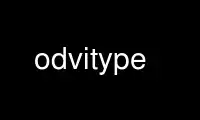
This is the command odvitype that can be run in the OnWorks free hosting provider using one of our multiple free online workstations such as Ubuntu Online, Fedora Online, Windows online emulator or MAC OS online emulator
PROGRAM:
NAME
dvitype, odvitype - translate a dvi file for humans
SYNOPSIS
dvitype dvi_name[.dvi]
DESCRIPTION
This manual page is not meant to be exhaustive. The complete documentation for this
version of TeX can be found in the info file or manual Web2C: A TeX implementation.
The dvitype program translates a DVI (DeVice Independent) file output by (for example)
tex(1) or gftodvi(1), to a file that humans can read. It also serves as a DVI file-
validating program (i.e., if dvitype can read it, it's correct) and as an example of a
DVI-reading program for future device drivers.
The output file can include all commands, just the important ones, or none at all (in
which case only errors are reported). A subinterval of pages may be selected for
transliteration; the magnification and resolution of the ``output device'' may be changed;
and so on. All options are specified with an on-line dialog.
The .dvi extension is supplied if omitted from dvi_name. The output goes to stdout.
OPTIONS
-dpi=REAL
Set resolution to REAL pixels per inch; default 300.0.
-magnification=NUMBER
Override existing magnification with NUMBER.
-max-pages=NUMBER
Process NUMBER pages; default one million.
-output-level=NUMBER
Verbosity level, from 0 to 4; default 4.
-page-start=PAGE-SPEC
Start at PAGE-SPEC, for example `2' or `5.*.-2'.
-show-opcodes
Show numeric opcodes (in decimal).
ENVIRONMENT
The environment variable TEXFONTS is used to search for the TFM files used in the DVI
file. See tex(1) for the details of the searching. If TEXFONTS is not set, it uses the
system default.
Use odvitype online using onworks.net services
